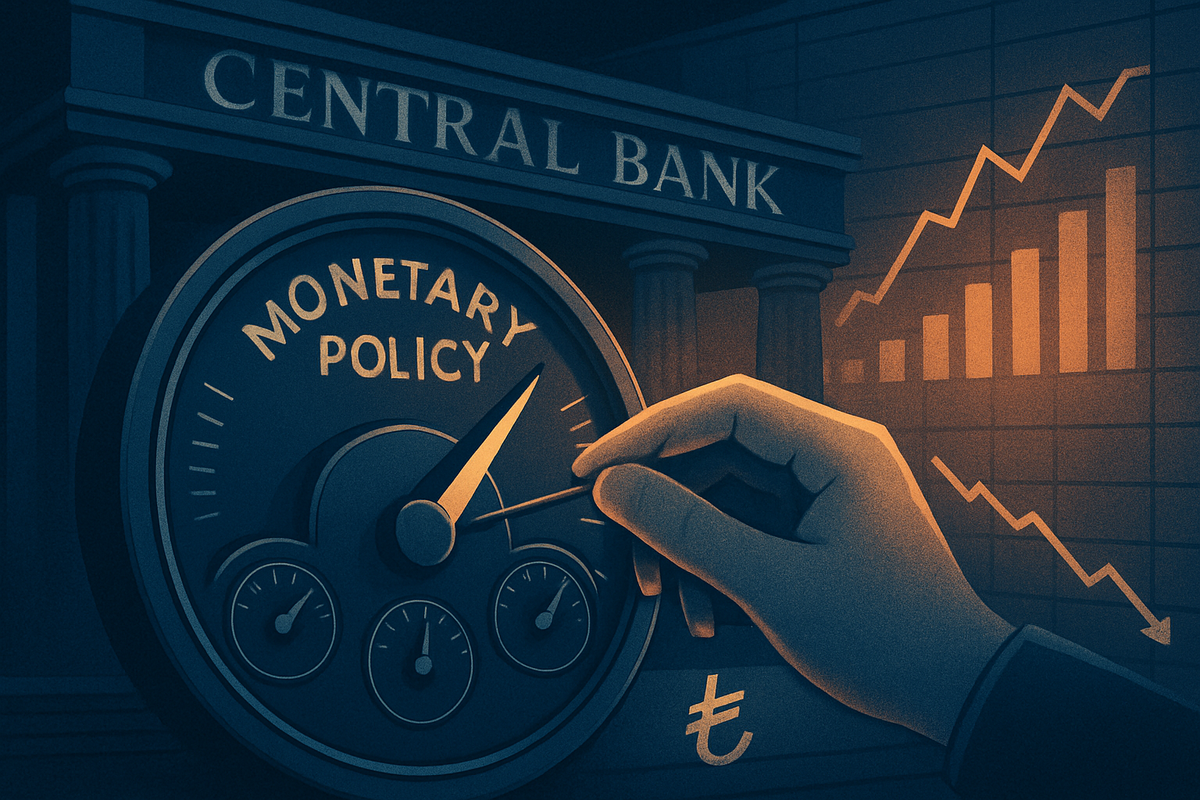
In a significant move signalling a strategic pivot, the Central Bank of the Republic of Turkey (CBRT) opted for a more cautious approach in its monetary easing cycle in October 2025. The bank reduced its benchmark one-week repo rate by a modest 100 basis points, bringing it to 39.5%. This decision marks a notable deceleration from the more aggressive rate cuts seen in previous months, reflecting growing concerns over persistent inflationary pressures.
The immediate aftermath of this policy adjustment saw the Turkish Lira continue its depreciatory trend, hitting a new record low of 41.9 per US dollar. This extended the Lira's year-to-date decline to approximately 18% and its fall over the last 12 months to 22.43%. The CBRT's measured approach, while aimed at steering the economy towards stability and rebuilding credibility, underscores the challenges faced in taming inflation and anchoring market expectations.
Policy Shift Unveiled: A Deeper Dive into the CBRT's Strategy
The CBRT's decision to slow the pace of interest rate cuts in October 2025 was a direct response to a confluence of economic indicators that suggested the disinflationary process was proving more challenging than anticipated. This move followed more substantial cuts of 300 basis points in July and 250 basis points in September, indicating a clear shift from an aggressive easing stance to one of increased prudence.
A primary driver behind this cautious pivot was the unwelcome resurgence of inflation. Turkey's annual inflation rate unexpectedly climbed to 33.29% in September 2025, up from 32.95% in August. This marked the first increase in the annual rate in over a year and surpassed market expectations, highlighting the stubborn nature of price pressures. The central bank specifically flagged risks from food prices, which were seen to be significantly impacting inflation expectations and pricing behaviour. Furthermore, while demand conditions were still considered supportive of disinflation, the actual pace of price deceleration had visibly slowed. Prior to the October meeting, senior CBRT officials reportedly communicated to foreign investors their growing concerns regarding persistent inflation, foreshadowing the need to moderate the pace of rate reductions. The bank reaffirmed its commitment to a "tight monetary stance" until its medium-term inflation target of 5% is achieved, emphasizing a data-dependent approach to future policy.
Initial market reactions were mixed but largely reflected the ongoing pressure on the Lira. The currency's continued depreciation suggests that while the CBRT's move was a step towards addressing inflation, it has yet to fully assuage investor concerns regarding the long-term stability of the currency and the broader economy. Key players involved include the CBRT's Monetary Policy Committee, which makes these crucial decisions, and the Ministry of Treasury and Finance, which works in tandem with the central bank to manage economic policy. International investors and domestic businesses are also critical stakeholders, as their confidence and investment decisions are heavily influenced by these policy shifts. The timeline of events saw a period of aggressive easing followed by this more cautious stance, suggesting an adaptive monetary policy framework reacting to evolving economic realities.
Navigating the Tides: Potential Winners and Losers in the New Policy Landscape
The Central Bank of Turkey's shift to a more cautious monetary policy creates a distinct landscape of opportunities and challenges for various sectors and public companies operating within the Turkish economy. The continued depreciation of the Lira, coupled with higher-for-longer interest rates compared to previous expectations, will undoubtedly reshape corporate strategies and investor sentiment.
Companies with significant foreign currency-denominated debt are likely to face increased financial strain. As the Turkish Lira (TRY) weakens against major currencies like the US Dollar (USD) and Euro (EUR), the cost of servicing these debts in local currency terms rises, impacting profitability and balance sheet health. Conversely, export-oriented companies stand to benefit. A weaker Lira makes Turkish goods and services more competitive on the international market, potentially boosting revenues and market share for major exporters. Examples could include automotive manufacturers like Ford Otosan (IST: FROTO) and Tofas Turk Otomobil Fabrikasi (IST: TOASO), or white goods producers such as Arcelik (IST: ARCLK), provided they can manage their import costs for raw materials and components effectively. The tourism sector, represented by companies like Turkish Airlines (IST: THYAO), could also see an uptick in foreign visitor numbers due to the increased purchasing power of foreign currencies.
On the domestic front, sectors heavily reliant on consumer spending, particularly those dealing in imported goods, may experience headwinds. The higher cost of imports due to the weaker Lira could translate to higher retail prices, potentially dampening consumer demand. Retailers and companies with high exposure to the domestic market might see their margins squeezed or sales volumes decline. Banks, such as Turkiye Garanti Bankasi (IST: GARAN) and Akbank (IST: AKBNK), will navigate a complex environment. While higher interest rates could theoretically boost net interest margins, the risk of non-performing loans might also increase if economic growth slows or corporate profitability deteriorates. Their resilience will depend on the quality of their loan books and their ability to adapt to a fluctuating interest rate environment. Ultimately, companies with robust balance sheets, strong cash flows, limited foreign currency exposure, and a focus on exports or essential domestic services are best positioned to weather the current economic adjustments.
Wider Significance: A Return to Orthodoxy and its Broader Implications
The Central Bank of Turkey's cautious monetary policy shift in October 2025 is more than just a tactical adjustment; it represents a significant step towards re-establishing monetary policy orthodoxy and addressing deep-seated economic imbalances. This move fits into a broader global trend where central banks are grappling with persistent inflation in a post-pandemic, geopolitically charged world, often necessitating a departure from unconventional easing measures. For Turkey, this pivot is particularly crucial as it seeks to rebuild credibility with international investors after years of unorthodox policies.
The potential ripple effects of this policy change are far-reaching. Regionally, a more stable Turkish economy, driven by credible monetary policy, could have positive spillover effects on neighbouring markets, fostering greater confidence in emerging markets more broadly. However, if the Lira's depreciation continues unabated despite the policy adjustments, it could trigger concerns about capital flight and financial instability in other susceptible economies. For competitors and partners, particularly those in Europe with significant trade ties to Turkey, the situation presents a mixed bag. A weaker Lira could make Turkish exports more attractive, potentially intensifying competition in certain sectors, but also making imports from Europe more expensive for Turkish consumers and businesses.
Regulatory and policy implications are substantial. This shift signals a renewed commitment to conventional economic management, which may pave the way for closer cooperation with international financial institutions and potentially unlock new avenues for foreign direct investment. It also underscores the government's recognition of the urgent need to address inflation, which has eroded household purchasing power and created economic uncertainty. Historically, periods of high inflation and currency depreciation in Turkey have often led to social unrest and political instability. The current policy recalibration aims to avert such outcomes by prioritizing price stability. Comparisons can be drawn to other emerging markets that have faced similar inflationary pressures and currency crises, often finding that a credible and independent central bank is paramount to restoring economic health. The CBRT's current stance, while challenging in the short term, is a necessary step towards securing long-term economic stability and growth.
The Road Ahead: Navigating Turkey's Evolving Economic Landscape
Looking ahead, the Central Bank of Turkey's cautious monetary policy sets the stage for a period of careful observation and adaptive economic management. In the short term, the market will be keenly watching upcoming inflation data releases and any further communications from the CBRT. The central bank's commitment to a "tight monetary stance" implies that future rate decisions will be highly data-dependent, with a strong emphasis on the trajectory of inflation and inflation expectations. Investors should anticipate continued volatility in the Turkish Lira as the market digests these policy signals and economic data.
In the long term, the success of this cautious approach hinges on its ability to effectively anchor inflation expectations and restore price stability. This could pave the way for a more predictable and stable economic environment, fostering greater foreign investment and sustainable growth. However, there are potential challenges. If inflation proves more entrenched than anticipated, or if global economic headwinds intensify, the CBRT might be compelled to maintain higher interest rates for an extended period, potentially dampening economic activity. Strategic pivots for businesses will involve prioritizing cost control, managing foreign exchange exposure, and focusing on efficiency. Export-oriented companies may find opportunities in enhanced competitiveness, while domestic businesses might need to adapt to more constrained consumer spending. Potential scenarios range from a gradual but sustained disinflationary process leading to economic normalization, to a more protracted battle against inflation requiring further policy tightening.
Market opportunities could emerge for investors willing to take a long-term view on Turkish assets, particularly in sectors resilient to inflation and currency fluctuations, or those with strong export potential. Challenges include managing currency risk and navigating a potentially slower domestic growth environment. The CBRT's credibility will be paramount; its ability to communicate clearly and consistently will be crucial in shaping market sentiment. This period will demand agility from both policymakers and market participants, as Turkey continues its journey towards economic stabilization.
Wrapping Up: A Critical Juncture for Turkey's Economy
The Central Bank of Turkey's shift to a more cautious monetary policy in October 2025 marks a critical juncture for the nation's economy. The key takeaway is a clear pivot towards a more conventional and data-driven approach to combating persistent inflation, even if it entails a slower pace of easing and continued pressure on the Turkish Lira. This strategic adjustment, driven by stubbornly high inflation and risks from food prices, underscores the CBRT's renewed commitment to price stability and rebuilding credibility after a period of unorthodox policies.
Moving forward, the market will remain highly sensitive to incoming inflation figures and the CBRT's forward guidance. The immediate impact has seen the Lira depreciate further, yet this is framed within a "managed" depreciation strategy aimed at benefiting exports. For investors, this environment necessitates a discerning approach, favoring companies with robust balance sheets, limited foreign currency debt, and strong export capabilities. Sectors like manufacturing and tourism, with their export potential, may find opportunities, while import-reliant and domestically focused businesses could face headwinds.
The wider significance of this policy shift extends beyond Turkey's borders, signalling a return to economic orthodoxy that could foster greater international confidence and potentially attract foreign direct investment in the long run. However, the path to sustained disinflation and economic stability is likely to be challenging and protracted. Investors should closely watch the CBRT's future policy decisions, the trajectory of inflation, and the government's broader economic reforms in the coming months. The success of this pivot will ultimately determine Turkey's economic resilience and its ability to achieve its medium-term inflation target, setting the stage for a more stable and predictable financial future.
This content is intended for informational purposes only and is not financial advice






